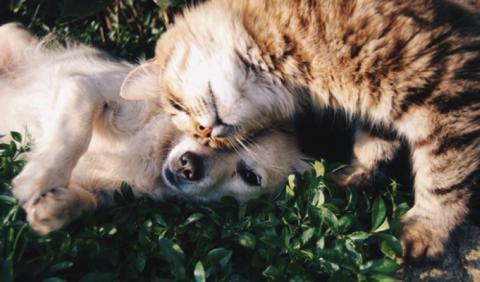
It seems a bit crazy, but pet owners aren’t the only ones following trendy diet fads. It’s becoming more and more common for pets themselves to be given diet-restricting “health” foods. Many of the pet foods that are currently riding the wave of popularity boast being grain free. So, the question remains—is grain-free pet food good or bad? The answer to that is complicated; let’s just say grain-free diets may work well for some of you, and some of your pets, but not all of them.
This past summer, just before the 4th of July, my Great Dane, Lana Jane, had fallen ill. She was gassy, pacing around, not eating (this big girl loves food), and vomiting. After spending the night at an emergency veterinary clinic, my mother and I had to go pick her up. Lana was not back to her normal self, but she refused to eat or go to the bathroom there because, like many of us, she has trust and anxiety issues. Ultimately, that strange environment was counterproductive. So, she came home with a diet plan recommended by a veterinary specialist.
What we learned was that the grain-free dog food we had been giving her was causing her to have an excruciating upset stomach. At first, we were to give her organic boiled chicken and white rice for a while. Yes, rice is a grain. Apparently, dog food with grain in it is perfectly fine, unless your dog has an allergy. Wild dogs eat animals with grain-based diets, and domesticated dogs can digest similar foods, too. However, pay attention to the ingredient lists on dog food bags because not all dog foods are up to par. Choose quality dog foods, which list a meat, not a grain, as the first ingredient. Don’t fall for those high-priced marketing schemes you frequently see on the shelves because, believe it or not, Spot is an omnivore.
On the other hand, I do buy my cat, Bruce Wayne, exclusively grain-free cat foods. Why? Cats are notoriously carnivorous animals. Truthfully, some grain won’t hurt, but cats require much more protein and fat than carbs. In fact, it is recommended that cats eat mostly, or all, wet food. Bruce gets a mixture of wet and dry simply because can food is rather costly. If you can afford it, look into feeding that feline more wet food, if not only. The hydrating moisture is necessary for optimal urinary tract and kidney function because cats tend to not drink enough water. So, grain-free, cheap filler-free cat foods, especially wet foods, can be a great thing. Plus, your cat(s) will love you that much more whenever you crack open a can of the good stuff.
Overall, grain free diets tend to be better options for cats than dogs. However, there are always exceptions to the rule. It’s important to remember that pets, like people, are all individuals.








